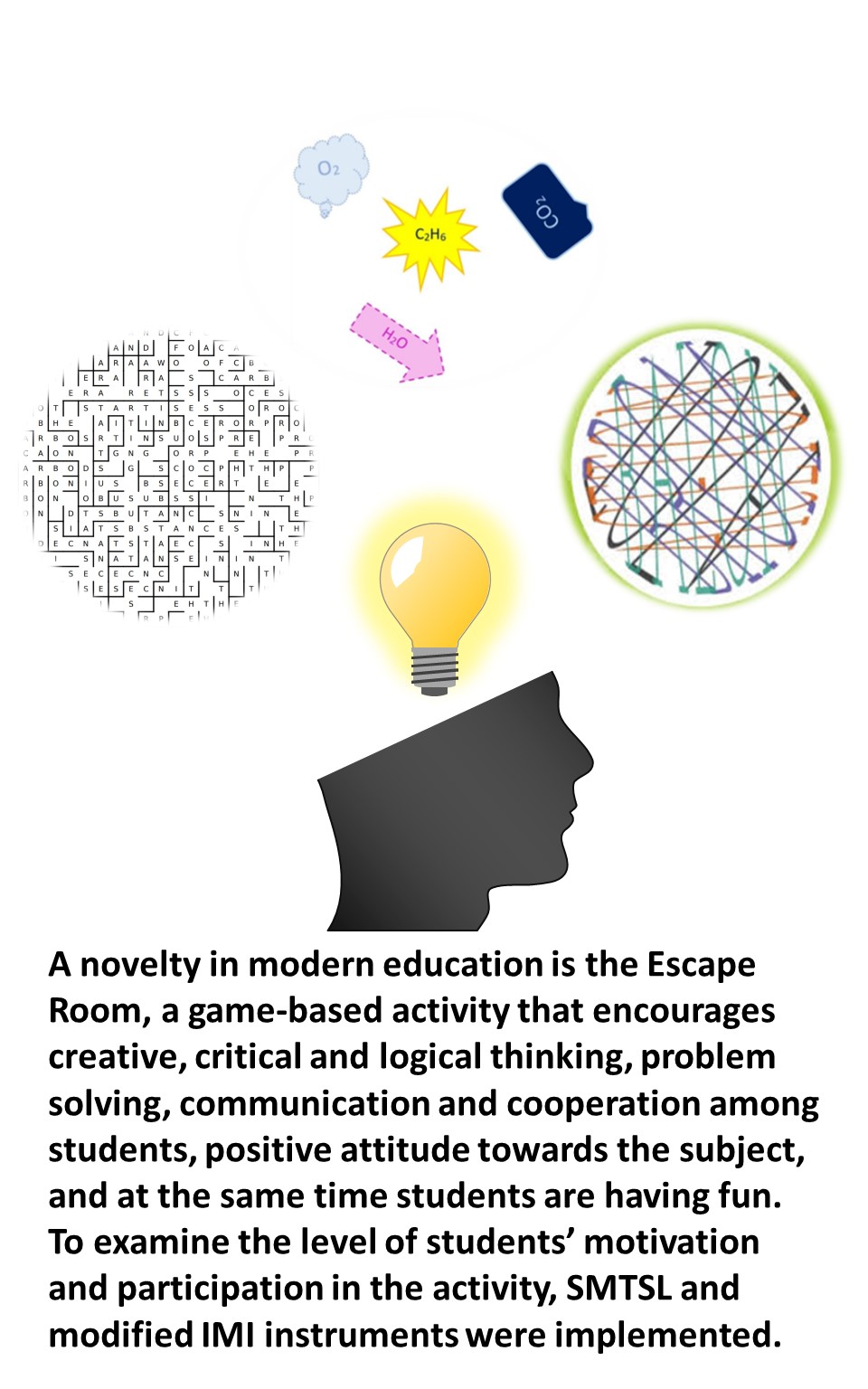Using the Escape Room game-based approach in chemistry teaching Scientific paper
Main Article Content
Abstract
In recent years, the Escape Room approach has been applied in teaching of various content. Aside from being enjoyable, the Escape Room activities actively involve all students in the class and promote their creative, critical and logical thinking, problem solving, communication and cooperation, as well as positive attitude towards the subject. To encourage the engagement and motivation of ninth-grade students, activities were developed regarding the topic of exothermic and endothermic reactions, through the use of Google Forms and Breakout Rooms option in MS Teams. The application of this approach helps students to master the teaching content in a more interesting way, encourages discussion and cooperation among students. 244 9th grade students from five primary schools participated in the research. Apart from encouraging engagement and motivation among students, one of the objectives of the research was to examine their opinions regarding the implemented Escape Room activities. For this purpose, the motivation of students towards Science Learning (SMTSL) and Activity Perception Questionnaire (APQ-ER) instruments were implemented. The research results, positive atmosphere during the classes, and high students’ satisfaction after completing the activities indicate numerous benefits of the implementation of the Escape Room approach in chemistry teaching.
Downloads
Metrics
Article Details

This work is licensed under a Creative Commons Attribution-NonCommercial-NoDerivatives 4.0 International License.

Authors retain copyright and grant the journal right of first publication with the work simultaneously licensed under a Creative Commons Attribution license 4.0 that allows others to share the work with an acknowledgement of the work's authorship and initial publication in this journal.
References
V. S. Zirawaga, A. I. Olusanya, T. Madaku, J. Educ. Pract. 8 (2017) 55 (https://files.eric.ed.gov/fulltext/EJ1143830.pdf)
M. J. Costa, J. Chem. Educ. 84 (2007) 977 (https://dx.doi.org/10.1021/ed084p977).
P. M. Noemí, S. H. Máximo, Univers. J. Educ. Res. 2 (2014) 230 (https://dx.doi.org/10.13189/ujer.2014.020305)
K. Becker, JCSC 17 (2001) 23 (https://dx.doi.org/10.11575/PRISM/30356).
J. Li, S. Ma, L. Ma, Phys. Procedia 33 (2012) 1749 (https://dx.doi.org/10.1016/j.phpro.2012.05.280)
J. Hamari, D. J. Shernoff, E. Rowe, B. Coller, J. Asbell-Clarke, T. Edwards, Comput. Hum. Behav. 54 (2016) 170 (https://dx.doi.org/10.1016/j.chb.2015.07.045)
A. J. Franco-Mariscal, J. M. Oliva-Martínez, M. L. Almoraima Gil, J. Chem. Educ. 2 (2014) 278 (https://dx.doi.org/10.1021/ed4003578)
Veldkamp, M. Ch. Knippels, W. van Joolingen, Front. Educ. 6 (2021) 1 (https://dx.doi.org/10.3389/feduc.2021.622860)
Manzano-León, J. M. Rodríguez-Ferrer, J. M. Aguilar-Parra, A. M. Martínez, A. L. de la Rosa, D. S. García, J. M. Fernández-Campoy, Int. J. Environ. Res. Public Health 18 (2021) 7304 (https://dx.doi.org/10.3390/ijerph18147304)
N. Dietrich, J. Chem. Educ. 95 (2018) 996 (https://dx.doi.org/10.1021/acs.jchemed.7b00690)
S. Nicholson, Peeking Behind the Locked Door: A Survey of Escape Room Facilities, 2015 (http://scottnicholson.com/pubs/erfacwhite.pdf)
L. H. Taraldsen, F. O. Haara, M. S. Lysne, P. R. Jensen, E. S. Jeensen, Educ. Inq. (2020) 1 (https://dx.doi.org/10.1080/20004508.2020.1860284)
M. Stojanovska, Maced. J. Chem. Chem. 38 (2019) 141 (https://www.mjcce.org.mk/index.php/MJCCE/article/view/1833/711)
M. Stojanovska, in Proceedings of April Days on Chemistry Teaching – 30th Professional training for chemistry teachers and 3rd Conference of methodology in chemistry teaching, Book of Abstracts, Serbian Chemical Society, Belgrade, Serbia, 2019, p. 3
W. Admiraal, J. Huizenga, S. Akkerman, G. ten Dam, Comput. Hum. 27 (2011) 1185 (https://dx.doi.org/10.1016/j.chb.2010.12.013)
J. C. Burguillo, Comput. Educ. 55 (2010) 566 (https://dx.doi.org/10.1016/j.compedu.02010.02.018)
Y. Orlik, E. Gil, L. C. Hernández, Nat. Sci. Educ. 3 (2005) 47 (https://dx.doi.org/10.48127/gu-nse/05.2.47b)
R. Peleg, M. Yayon, D. Katchevich, M. Moria-Shipony, R. Blonder, J. Chem. Educ. 96 (2019) 955 (https://dx.doi.org/10.1021/acs.jchemed.8b00406)
M. Stojanovska, V. Milanović, D. Trivić, Chem. in Act. 116 (2020) 49 (https://www.chemistryireland.org/wp-content/uploads/2020/12/Chemistry-in-Action-Autumn-2020-Issue-116.pdf)
Lathwesen, N. Belova, Educ. Sci. 11 (2021) 308 (https://doi.org/10.3390/educsci11060308)
J. W. J. Ang, Y. N. A. Ng, R. S. Liew, J. Chem. Educ. 97 (2020) 2849 (https://doi.org/10.1021/acs.jchemed.0c00612)
S, Marín, P. R. de Atauri, E. Moreno, S. Pérez-Torras, J. Farràs, S. Imperial, M. Cascante, J. J. Centelles, Int. J. Eng. Sci. Technol. 3 (2021) 155 (https://doi.org/10.46328/ijonest.59)
K. Rusevska, A. Blazevska, M. Stojanovska, IPEM J. Innov. Teacher Educ. 7 (2022) 27 (ISSN 2581-5881)
M. Stojanovska, in Proceedings of the International Conference on Education in Mathematics, Physics and Related Sciences, Society of Physicists of Macedonia, Skopje, North Macedonia, 2019, 140
Intrinsic Motivation Inventory (IMI), Center for Self-Determination Theory, https://selfdeterminationtheory.org/intrinsic-motivation-inventory/#:~:text=Scale%20Description,target%20activity%20in%20laboratory%20experiments (assessed March, 2021)
H. L. Tuan, C. C. Chin, S. H. Shieh, Int. J. Sci. Educ. 27 (2005) 639 (https://dx.doi.org/10.1080/0950069042000323737)
M. Gutiérrez, N. Caus, L. M. Ruiz, J. Leis. Res. 43 (2011) 355 (https://dx.doi.org/10.1080/00222216.2011.11950241)
E. Y. Leng, W. Z. bte Wan Ali, R. Baki, R. Mahmud, Eurasia J. Math. Sci. Technol. 6 (2010) 215 (https://dx.doi.org/10.12973/ejmste/75242)
Loukomies, D. Pnevmatikos, J. Lavonen, A. Spyrtou, R. Byman, P. Kariotoglou, K. Jauuti, Res. Sci. Educ. 43 (2013) 2517 (https://dx.doi.org/10.1007/s11165-013-9370-1)
V. Monteiro, L. Mata, F. Peixoto, Psicol. Reflex, Crit. 28 (2011) 434 (https://dx.doi.org/10.1590/1678-7153.201528302)
C. Tsai, H. L. Tuan, C. C. Chin, J. C. Chang, in Proceedings of the 2nd NICE Symposium, Graduate Institute of Science Education, National Taiwan Normal University, Taipei, Taiwan, July 30–31, 2007, No. 00057 (https://www.researchgate.net/profile/Hsiao-Lin-Tuan/publication/237634754_Investigating_the_Influence_of_Nested_Inquiry-Based_Instruction_Model_on_8th_Graders%27_Motivation_in_Learning_Physical_Science/links/56c7ed2c08ae96cdd0679db7/Investigating-the-Influence-of-Nested-Inquiry-Based-Instruction-Model-on-8th-Graders-Motivation-in-Learning-Physical-Science.pdf)
Mavrakaki, Int. J. Biol. Educ. 4 (2015) 78 (https://dx.doi.org/10.20876/ijobed.16761)
Dermatzaki, D. Vavougid, K. Kotsis, Eur. J. Psychol. Educ. 28 (2013) 747 (https://dx.doi.org/10.1007/s10212.012.0138.1)
L. Cohen, L. Manion, K. Morrison, Research Methods in Education, Routledge Falmer, London, 2007, p.506 (https://doi.org/10.4324/9780203029053)
Choi, T. Mogami, A. Medalia, Schizophr. Bull. 36 (2010) 966 (https://doi.org/10.1093/schbul/sbp030)
H. Andressa, E. Mavrikaki, I. Dermitzaki, Int. J. Biol. Educ. 4 (2015) 78 (https://dx.doi.org/10.20876/ijobed.16761)
P. Cavaş’s, Sci. Educ. Int. 22 (2011) 31 (https://files.eric.ed.gov/fulltext/EJ941653.pdf)
Jiménez, N. Aris, A. A. Magreñán, L. Orcos, Sci. Educ. 10 (2020) 271 (https://dx.doi.org/10.3390/educsci10100271)
A. Kinio, L. Dufresne, T. Brandys, P. Jetty, J. Surg. Educ. 76 (2019) 134 (https://dx.doi.org/10.1016/j.jsrug.2018.06.030)
B. C. T. Gilbert, M. L. Clapson, A. Musgrove, J. Chem. Educ. 97 (2020) 4055 (https://dx.doi.org/10.1021/acs.jchemed.0c00863)
Queiruga-Dios, M. J. S. Sánchez, M. Q. Dios, V. G. Martínez, A. H. Encinas, Mathematics 8 (2020) 166 (https://dx.doi.org/10.3390/math8020166).





